Travel Trunks of Treasure
by Jessica Kosinski
Few items epitomize the Golden Age of Travel more than travel trunks. Steamer trunks and wardrobes of all sizes and descriptions were used by travelers, whether they were passengers on ocean liners, stage coaches, or trains. Today the speed of travel has increased, which means many people do not have to carry as many items with them on their journeys, but years ago some people brought their entire lives with them in steamer trunks, also known as traveling chests. Many of those steamer trunks have survived to the present day. They have both monetary value and a great deal of historical significance. Let’s take a peek at how they came into being and the purposes they served, as well as how they can still be utilized today.
The Purposes of Traveling Trunks
In the early days of travel, especially stagecoach or steamboat travel, what we now consider to be a relatively short trip took a very long time. It was necessary for travelers to find convenient ways of carrying all of their necessities with them. Carrying devices had to be sturdy enough to withstand the elements and rough travel. They also had to be elaborate enough to hold items of varying sizes securely. In addition to trunks for water or stagecoach travel, some traveling trunks were used when railroads were popularized. Such trunks were also used by boarding school students who needed to have all of their belongings with them at any given time.
While various forms of trunks and chests existed as far back as medieval times, it wasn’t until the 1800s that travel trunks as we know them today really gained popularity. Earlier versions were generally constructed and used out of necessity, but the 1800s (particularly the 1870s onward) saw a major change. Travelers in that time period did use their travel trunks for necessities, but many of them also viewed trunks and chests as status symbols.
Both interiors and exteriors of trunks became more elaborate with the changing times. The insides often featured compartments for almost anything a traveler could want. In fact, many wealthy travelers had custom-made trunks just for their belongings. Many travelers also took up the practice of adhering travel stickers (luggage labels) to their trunks. Although the earliest luggage labels known to have existed did pop up in the 1800s, the practice didn’t hit its heyday until after the turn of the 20th century.
Popular Traveling Trunk Types
Travel trunks came in many sizes, types, and styles, but a few stood out as among the most popular. Flat-topped versions were quite common for practical purposes because they could be stacked for travel. Many of them were also designed to be stood on their sides and then opened to take up as little space as possible. They were known as wardrobe trunks or steamer trunks.
An even more space-saving model was called a wall trunk. It was so named because it could be positioned against a wall and opened without any trouble. Many other types of trunks needed to be out from the wall because of the ways in which their lids were hinged.
Fancier trunk types included the Jenny Lind and the Saratoga varieties. Saratoga trunks were popular with the wealthy and therefore tended to be very elaborate. Many of them were made out of materials such as metal or leather. Their latches and hinges often featured elaborate designs. Jenny Lind trunks were elaborate and unusual in terms of the shape of the trunks themselves, which often resembled loaves of bread when viewed from a side angle. They got their name from a Swedish singer who toured the United States with a trunk of that type.
Of course, dome-topped trunks were also popular around the same time periods. They also go by names that include “barrel-top” and “camel back” or “humpback.” However, trunks with domed tops could not be stacked as easily for travel. Many of them were more like chests, which people stored valuables in at home. Those who did travel with such trunks in tow often did so out of necessity, such as when moving permanently to a new place.
Perhaps the most famous maker of traveling trunks is Louis Vuitton. Louis Vuitton founded his company in 1854, but did not produce his first travel trunk model until 1858. That model was the first flat-topped trunk. Previously having trunks with domed tops was considered to be more practical because moisture could run off of them, but Vuitton saw the need for trunks that could be stacked in ship cargo holds. The LV Company, as it is often called, went on to produce many other lines of luggage after that original model. Moynat and Truesdale are two other famous makers of travel trunks. Others on the list of well-known trunk makers include Malloy and Goyard. Many of the best makers of travel trunks, also known as malletiers, were based in France. Antique French travel trunks are among the most sought after to this day, especially early Louis Vuitton models.
Restoring and Re-Purposing Antique Traveling Trunks
Obviously, large trunks are not as practical for actual traveling in today’s world of fast and easy travel. However, antique travel trunks have not lost their popularity. If anything, they have gained followings across the country. Many people find that adding a travel trunk to a room can give that room a unique appearance, as well as offering a practical storage option in an otherwise difficult space.
One common practice is to place a sheet of glass over a flat-topped steamer trunk and turn it into a coffee table. Another possibility is that you could turn an old flat-topped trunk into a window seat by adding a few cushions on top. You can easily take the cushions off again anytime you want to access whatever you choose to store inside the trunk.
As far as restoring damaged travel trunks goes, the first question to ask is whether or not you really need to. Often, minor damage or wear can give a trunk a lot of character. It shows that the trunk has truly traveled. You never know where in the world it may have been and what ordeals its original owner may have gone through. But, if you do find a travel trunk you want to restore, the best idea is to take it to an expert who is familiar with restoring such pieces already. Depending on the material it is made out of, its age, and what sort of damage it has, the restoration process may be a delicate one.


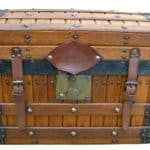
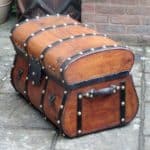
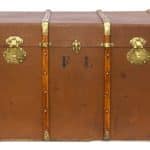

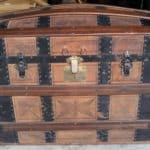
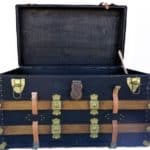
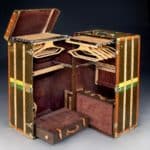



Related posts: